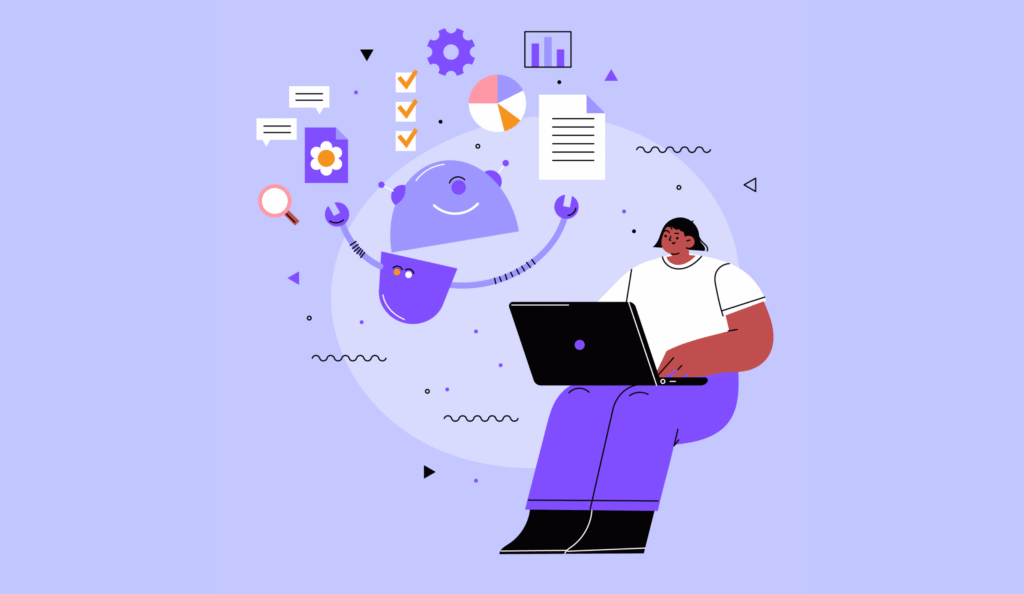Table Of Content
In today’s rapidly evolving technological landscape, artificial intelligence (AI) has emerged as a foundational, transformative force—a general-purpose technology akin to electricity. Just as electricity revolutionized industries by powering an endless array of innovations, AI now promises to reshape business processes and product development across every sector.
As organizations look to utilize this potential, it becomes imperative to understand the underlying technology and the evolving methodologies that drive practical, scalable applications. A key paradigm in this evolution is the adoption of agentic workflows, a concept that is redefining how AI systems are designed, prototyped, and integrated into business operations.
The AI stack comprises the foundational layers—ranging from cloud-based AI infrastructure and core models to data management, deployment, orchestration, and finally, the application layer—that enable the operation of AI systems. On top of this stack, agentic workflows, or AI agents, leverage these underlying technologies to perform complex tasks.
At the application layer, sophisticated AI models are deployed to solve real-world problems, drive revenue, and create new opportunities. The true competitive advantage lies in developing innovative applications that leverage these advancements.
Traditional AI development processes were often slow and labor-intensive. Building an AI application involved many months of effort in collecting and labeling data, model training, and deployment and integration. Such long development cycles meant that only large, well-resourced teams could afford to experiment extensively with AI.
However, the emergence of generative AI has fundamentally altered this landscape. With new generative models, developers can now produce functional prototypes in days rather than months. This speed reduces time-to-market and enables iterative experimentation, allowing teams to test and refine multiple ideas in parallel quickly.
What is Agentic AI?
One of the most compelling developments in this space is the rise of agentic workflows. The concept of “agentic AI” refers to using AI systems capable of self-directed, iterative problem-solving—systems that can plan, execute, and refine their own outputs.
Agentic workflows break away from the conventional one-shot approach where an AI is given a prompt and expected to generate a final output. Instead, these workflows incorporate multiple stages of reflection, tool use, planning, and even multi-agent collaboration to improve performance and robustness.
The process begins with reflection. Traditional AI systems generate outputs in a single pass; however, an agentic workflow introduces a feedback loop where the AI reviews and evaluates its work. This self-reflection process, like a writer revising a draft, allows the system to identify errors, propose improvements, and generate a refined output. The result is a significantly enhanced performance, particularly in complex tasks where a single pass might fall short of the desired quality.
Agentic AI is an umbrella term encompassing the overall process—agentic workflows—and the individual components, or AI agents, that execute specific tasks within that process. AI agents are the specialized entities that carry out these functions.
Integration with the Ecosystem of Tools
Modern AI models are now being tuned to integrate with external tools and services. Instead of attempting to solve every problem internally, an agentic system can decide when to call external APIs, fetch data, or even run specialized code. This flexibility allows AI agents to expand their functional reach, bridging the gap between pure computation and real-world application. For businesses, investments in AI should consider the models and the ecosystem of tools that can amplify their capabilities.
Planning- Structured Reasoning
Another critical design pattern in agentic workflows is planning or structured reasoning. For tasks requiring multiple steps—such as writing an essay, generating a detailed report, or processing visual data—the AI first decomposes the problem into manageable subtasks.
For instance, consider an AI tasked with designing a custom user interface (UI) for a mobile application. This process integrates AI UX Design by focusing on functionality and the overall user experience. The approach might begin by analyzing existing design patterns, user behavior data, and established UX principles to draft an initial UI layout incorporating key usability, accessibility, and aesthetic elements.
The AI agent then generates a prototype, simulates user interactions to gather feedback, and iteratively refines the design based on its internal assessments. This cycle continues until the interface meets functional requirements and delivers an optimal user experience.
This iterative, self-improving process exemplifies how agentic workflows tackle complex design challenges by continuously learning and adapting, producing more coherent, accurate outputs aligned with human problem-solving strategies. Planning in AI workflows thus helps set realistic expectations and design projects that maximize the system’s potential.
AI Multi-Agent Collaboration
A key aspect of agentic systems is the multi-agent collaboration. Rather than relying on a single AI instance to handle every aspect of a task, modern systems simulate a team of specialized agents. Each agent may take on a specific role—for example, one might focus on generating content while another evaluates and refines it. This division of labor mirrors the collaborative nature of human teams, where specialists work together to achieve a common goal. The synergy generated through multi-agent collaboration has been shown to dramatically improve performance on complex benchmarks, further emphasizing the importance of this approach in high-stakes applications.
These principles extend beyond text-based tasks to transform visual and voice data processing. For instance, consider an application in healthcare that uses agentic workflows to analyze radiology images. One specialized agent might focus on detecting anomalies within an image, such as potential lesions or irregular tissue structures. Simultaneously, a second agent reviews the patient’s medical history and integrates relevant clinical data, while a third agent compares the findings with a vast repository of similar cases to recommend possible diagnoses.
This collaborative approach speeds up the diagnostic process and enhances accuracy, providing healthcare professionals with comprehensive insights that can lead to more effective treatment decisions.
Moreover, this process is faster than traditional manual annotation and significantly more scalable. Similarly, AI agents can generate detailed metadata for audio files and large archives of images or video content, enabling businesses to perform nuanced searches and derive previously unattainable insights.
Data Engineering for Agentic AI
The implications for businesses are profound. As organizations accumulate vast amounts of unstructured data—textual, visual, or audio—the need for robust data engineering becomes imperative. Agentic workflows enhance the ability to process this data efficiently, turning raw information into actionable insights. For enterprises, the true competitive advantage lies in the capacity to harness data through sophisticated AI-driven applications.
Historically, much of the value in machine learning was derived from structured data—tables of numbers and predefined formats. However, the current wave of generative AI applications unlocks the potential of unstructured data, including text, images, and videos. The challenge is managing and engineering this unstructured data to maximize its value.
DevOps and MLOps
Moreover, accelerating prototyping through generative AI is forcing a broader shift in the development lifecycle. While the machine learning component of application development has seen dramatic improvements in speed, other aspects—such as design, integration, deployment, and maintenance—must also evolve to keep pace. The emergence of DevOps and MLOps practices is a testament to this need for faster, more integrated processes.
This evolution represents challenges and opportunities; the pressure to modernize legacy systems and the potential to unlock new revenue streams and efficiencies through rapid innovation are increasing.
Safety and Responsibility
It is also critical to address the issue of safety and responsibility in the context of AI, where errors can have significant real-world consequences, a more balanced approach is required. Modern AI development must embrace a philosophy of speed and promote responsible AI. This means implementing robust evaluation protocols, continuous testing, and ensuring that any prototype or deployed system undergoes rigorous scrutiny before reaching the public. The stakes are high—missteps in AI applications can lead to reputational damage, regulatory challenges, and even direct harm to users.
Agentic AI Trends
Several trends are poised to shape the future of agentic workflows and AI application development. First, there is an increasing emphasis on optimizing token generation—whether in text, visual data, or other formats as agentic workflows drive a higher volume of token-based processing (generating, analyzing, or manipulating more tokens quickly and cost-effectively), hardware and model efficiency innovations will be crucial to sustaining this momentum.
Fine Tuning AI Models
Second, AI models are being retooled (fine-tuned) to support more effective tool use. Recent developments have seen models fine-tuned to answer questions and execute specific tasks—such as interfacing with external APIs or automating routine operations. This shift allows AI systems to proactively integrate into the operational fabric of organizations rather than merely reacting to inputs.
Open Weight Models
Another transformative trend is the rise of open-weight models. Traditionally, advanced AI has been associated with high infrastructure costs and proprietary constraints. Open-weight models are changing this dynamic by lowering costs, enabling customization, and granting businesses greater control over AI deployment. These models allow organizations to train, fine-tune, and deploy AI with reduced computational resources, significantly accelerating development cycles and reducing time to market for AI-powered products.
In addition to these trends, two rapidly advancing fields stand out as transformative:
Visual AI
- While text processing has become widespread, visual AI is just beginning to reveal its transformative potential.
- The ability to extract actionable insights from images and videos spurs innovation across healthcare, retail, entertainment, and security sectors.
- For stakeholders, understanding and integrating visual AI capabilities is essential for staying competitive in an increasingly data-driven landscape.
Voice AI
- Voice AI is emerging as a powerful tool capable of accurately converting spoken language into actionable data while interpreting tone and sentiment.
- This technology revolutionizes industries, including customer service, healthcare, automotive, and smart home solutions, by enabling natural, responsive interactions.
- For stakeholders, monitoring advancements in voice AI and integrating these capabilities into existing systems is critical for enhancing user experiences and maintaining market leadership.
These advancements lower infrastructure costs, enhance flexibility, and translate into tangible business benefits. By reducing expenses and accelerating development cycles, companies can achieve improved scalability and a higher return on investment, positioning themselves to capitalize on rapid market changes.
Key Takeaway
The evolution of AI application development is marked by a fundamental shift towards agentic workflows—systems that are not only faster and more efficient but also more adaptive and capable of handling complex, multi-step tasks. The entire AI stack is transforming from the foundational layers of hardware and cloud infrastructure to the innovative application layer where true business value is realized. Rapid prototyping enabled by generative AI, combined with iterative processes, sets the stage for innovation.
For business leaders, the message is clear: the future of AI is not confined to isolated models or one-off applications. Instead, it lies in the ability to build integrated, agentic systems that leverage the full spectrum of technological advancements. By embracing these new workflows, organizations can accelerate their innovation cycles and unlock unprecedented value from their data assets. The journey toward this future requires a balanced approach that combines rapid experimentation with responsible, rigorous development practices.
As companies adapt to this evolving AI landscape, the importance of a strategic vision encompassing technical excellence and business acumen cannot be overstated. The rise of agentic AI workflows offers a roadmap for achieving this balance, empowering stakeholders to reimagine how applications are developed, deployed, and scaled in a world where speed, flexibility, and precision are paramount. In essence, generative AI application development has entered a transformative stage, powered by the intelligent, iterative, and collaborative force of agentic AI
By understanding and investing in these emerging trends, decision-makers can ensure that their organizations remain at the forefront of innovation, poised to capitalize on the transformative potential of AI in an increasingly competitive global marketplace.
Krasamo’s AI Development Services
- AI UX Design
- End-to-End AI Application Development
- Data Engineering and Integration
- Custom AI Agent Solutions
- DevOps and MLOps Optimization












I wholeheartedly agree with the notion that multi-agent collaboration is the future of AI development. As we begin to implement generative AI strategy in our own projects, I believe it’s essential to adopt this collaborative approach to unlock maximum efficiency and accuracy. What are your thoughts on integrating agentic workflows in high-stakes applications?
I thoroughly enjoyed reading this thought-provoking blog post on agentic workflows and AI application development. As a digital marketer with some experience in AI, I appreciate the emphasis on optimizing token generation and fine-tuning AI models for more effective tool use. This forward-thinking approach is essential for leveraging machine learning consulting services to drive business growth and efficiency. Well-written and informative – thank you for sharing your expertise!
Don’t worry, I’ve got faith in our ability to adapt! Machine learning consulting services like ours are already tackling these challenges head-on by integrating responsible AI practices into every stage of the development process 💡👍.
This post is so on point! I’ve been exploring generative ai strategy for our team’s next project and it got me thinking… what do you guys think about incorporating agentic workflows in our dev process? Would love to hear your thoughts on how to make AI more accessible to non-technical users!